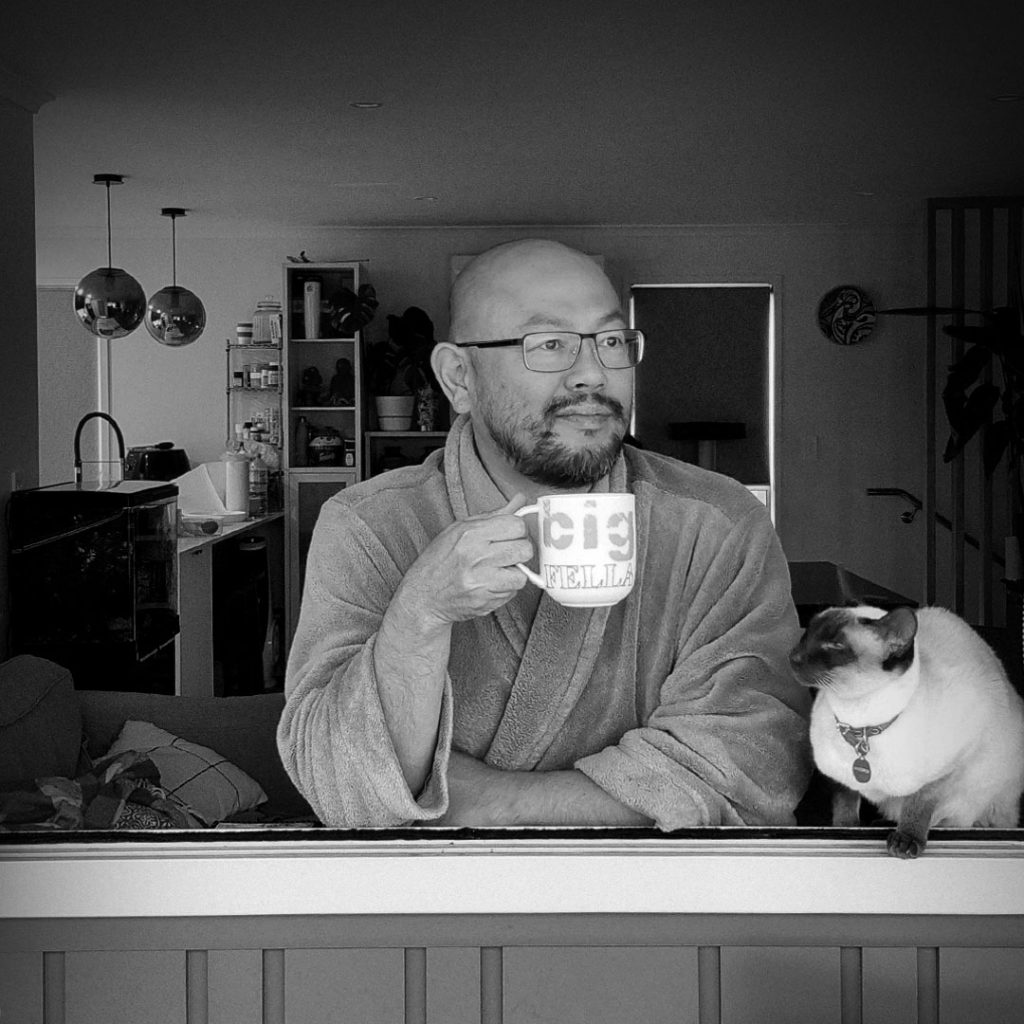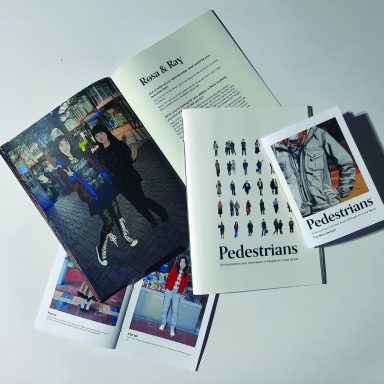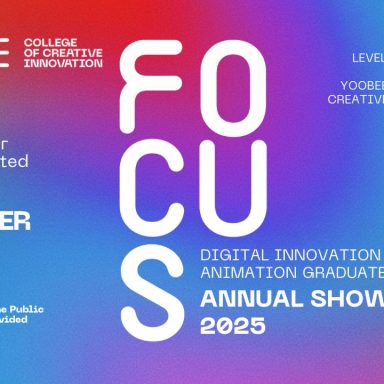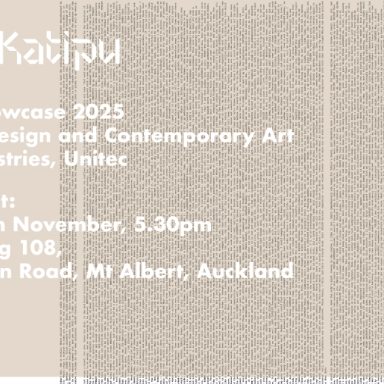By Day, By Night . . . Don Chooi
By Day, By Night is an interview series that profiles graphic design tutors from design schools throughout New Zealand. We learn about their role as a teacher and their own personal design practice.
Today we chat with Don Chooi, Senior Lecturer for the Bachelor of Media Design and Graduate Diploma of Creative Technologies at Media Design School, on his recent book project – ‘Conversations with my Ghost,’ a semi-autobiographical graphic novel which explores the grief of losing a longtime partner through the gay perspective.
Proudly sponsored by Media Design School


Kia ora Don. Can you tell us a little bit about your background, your career path, and how you got into teaching?
Kia ora! I came to New Zealand from Malaysia in 1996, at the age of 21, to wrap up my studies at AUT (back when it was still AIT – Auckland Institute of Technology) in the undergraduate Bachelor’s Degree in Graphic Design. Although it was a massive culture shock, my time acclimatising to New Zealand culture was incredible. I began my career as a graphic designer immediately after finishing my studies and after a couple of years, decided to make New Zealand my home. My interests at that time kept me working in smaller, boutique, design agencies and studios – as I found it exciting to be in a multi-modal and multi-faceted practice (I was learning so much and was expanding my skillsets into fields that went beyond graphic design). I spent 15 years in the industry before an opportunity to teach came along in 2011. This was at Media Design School and the position was for a part-time graphic design tutor delivering in the evening classes. I did approach it with great hesitancy and was doubtful of my capability being an educator. Thankfully, the experience was so enlightening and rewarding that I applied for a full-time role when it became available, in the department of Media Design, teaching in the Diploma of Graphic Design, and later in the Bachelor’s Degree of Media Design. I continued my journey as a student when I re-entered higher education in 2015, and completed my post-graduate studies in Art and Design – Honours and Master degree programmes (both at AUT) in 2015 and 2017 respectively. I now consider myself as a budding researcher.
What are you currently exploring in your design practice right now and how does your personal practice feed into your role as an educator?
My design practice is a bit more diversified now, as I am not only focussing on the role of graphic design in industry and education but branching into ‘hypermedia’ (a more contemporary term of ‘multimedia’ perhaps?) and into the fields of user experience and storytelling (in a digital age). Although my domain of practice lies mostly in the digital, I am also an illustrator and artist. While I utilise traditional methods of drawing and painting to tell stories that are autobiographical and self-reflective, I am intrigued with merging the analogue with the digital – a hybridity of sorts – that could facilitate a deeper connection for understanding and empathy between the storyteller and the viewer. It is with a penchant for the curious, for the speculative and “what-ifs”, that I bring into the classroom – to foster and imbue the learners with the same notions of curiosity, investigation and innovation in their own learning journey. I am a huge advocate for ‘failure’ – as I always believe in the adage that it is “better to fail now and quickly, to learn from it, and do better to succeed”. I would like to have my learners feel comfortable about being genuine in their design process and be accountable for their own learning.


Following on from that, how do you balance these two roles – educator and practitioner? Are there any particular benefits and/or challenges?
It is important to note that the nature of my design practice and research involves the concepts of authenticity and genuine self-reflection, and therefore it is difficult to separate the practice from the personal, the practitioner from the educator. I present myself in the classroom (as in life) as a gay, immigrant, asian man, and in that itself poses a few challenges that affect my teaching andragogy and my personal, cultural self. My research itself involves areas of gay identity, gay bears, erotic art, belonging and body representation. There are certain anxieties when I bring these ideas as research and practice process into the classroom of adult learners. I am confronted by stereotype, tokenism and in some instances, a threat to my personal and cultural safety. However, I do feel that there are great positives in being an educator and practitioner who is able to connect intellectually, and philosophically with the learners on their learning journey – and in this regard, more empathetic. I believe I am able to cultivate a sense of safety and approachability with the cohort, and advocate for the gentler and often marginalised, voices in the classroom.
You recently went on a research sabbatical which gave birth to your most recent semi-autobiographical graphic novel, ‘Conversations with My Ghost.’ Can you share a bit about your research journey and design process behind the project?
‘Conversations with a Ghost’ is a semi-autobiographical graphic novel that is self-authored and illustrated. Having experienced the death of my longtime partner of 15 years in 2018, I struggled with the grief and was unable to cope with the loss. His death shook my sense of self-confidence and my spiritual foundation. Admittedly, this creative project began as an attempt to reconcile with his passing and not primarily meant for academic assessment. Although I approached this project with great trepidation and doubt in the beginning, the research journey and the making of the graphic novel gave me a sense of purpose and intent. I was aware that, as the story was dealing with a deeply personal subject, it was difficult to be an objective researcher. Therefore, to avoid the impression that this was a self-indulging, tokenistic attempt, it was crucial that this project was to be embedded with qualitative research measures that recognise immersive research and lived experience.
I began with having informal conversations with my peers in the gay community and realised that although the themes of grief and loss is a universal experience, there is much still to say about the level of grief felt from a gay perspective. These were stories of being discriminated against, rejected at levels of legislation, medical care and from family, stories identity being eroded and lost, and being marginalised even further by society and even their own community. It was then I decided to write a story that captured these voices, while reflecting my own experiences – and thus my graphic novel took shape as ‘semi-autobiographical’. This approach also gave me the flexibility to take certain creative measures in shaping the story and its characters.

Contextually, I took references from several sources that spoke of gay grief, lived experiences, toxic masculinity and cultural interpretations of the afterlife – such as Chinese and Māori beliefs. I wanted the story to be imbued with meaning, not just from a personal worldview but also to consider a level of sensitivity to a collective spiritual experience.
I attempted to follow a design-led approach, so I incorporated peer feedback in my process. At various stages, feedback was sought from a selection of peers and professionals to determine whether the story is being told in the manner as it intended to be, and thus determined the success of my story and art.
The illustration stage was messy! I had to consider an optimal flow in illustrating the pages from the pencilling to inking, colouring and to scanning. At 144 pages, this was not an easy task, as I made mistakes and had to redraw or to rethink some pages. Being such a manual process, each iteration and amendment costed me in time and resource. I also did not have a studio space large enough to contain these pages set out to dry after colour being applied in watercolour. I had to rely on a hairdryer to expedite the drying time.
Throughout these stages, I found myself in a better state of creativity and productive when being in a certain environment or mood. Be it in a room or at a desk, there were certain preparations I made to get myself in a ‘conducive mood’. I practiced certain rituals where I would put on meditative music and had incense burning to lead me into a state of immersion and creativity.
Additionally, there were parts of the day where I would procrastinate and am unable to think in a creative manner. I would give myself permission to ‘slack off’ – either to recover and compose myself, or to gather my creative wits, but would be mindful of the time for efficacy’s sake.
It is also important to note that my cat served as my companion throughout the process. She became my muse and her constant presence served as an emotional support post.


Tell us about your choice for opting with a comic style for the novel. How did this format help you communicate your personal experience of grief and loss?
I always found great joy in reading comics and graphic novels since I was a child – they were my form of escapism into imagination. This may have given me the impetus to learn to draw and illustrate, and to be able to tell stories with art. To be honest, I did consider putting together a graphic novel which is self-authored, fully illustrated (and designed) to be a daunting feat. However, I had my first foray in creating a graphic novel during the time in my post-graduate studies as an exegesis in 2017. That was also autobiographical in nature, so I applied the learnings I made into “Conversations with my Ghost” – from the writing approach, characterisations, narrative flow, the panel illustration and design and even to typography. I do not presume myself to be a writer, but I found it comforting to be able to put down the words, type the ‘conversations’ and to subsequently visualise the scenes that played in my head – the self-same scenes and questions that play in my mind following the death of my partner. They say ‘pictures paint a thousand words’, and in this regard, the format of a graphic novel allowed me to portray this abstract, ambiguous, sense of “loss” through illustration and text.
The one thing I did not anticipate was having to deal with the memory and associated emotions from the loss at every step of the making process. As I am illustrating and designing the graphic novel, each detail of the work would serve as a constant reminder and it would drain me emotionally. I had to take frequent breaks to recompose and recentre myself.
Also, it is important to note that this graphic novel was not meant to act as, or to replace, therapy. It is merely a creative expression. I have come away from this project with a deeper understanding of my own trauma and experiences. This does not mean that I have wholly removed the need to seek further counselling, but in doing this project, the journey has given me an insight to my own manner of thinking. Remarkably, it has been a cathartic experience as it has allowed me to voice my emotions – frustration, anger and doubt – and to see and read it, has rekindled my spirituality and mystic self, thus giving me the opportunity to centre my sense of ‘self ’.
What’s next for ‘Conversations with My Ghost’? Are you planning on holding any talks or launching it into print?
Originally, the intent was to launch the work in a digital format (as an Ebook or Epub format). However, when I had the graphic novel printed in hardcopy as a test, my opinion has shifted. It became evident that the tangibility of reading the work as a physical book, made the reading experience more enjoyable, and in turn, became relatable and easier to understand. I am now currently investigating the options of having it published. I am keen to hold talks and presentations for the work and its process in both educational and promotional capacities.
And, finally, where can we see more of your own work (links to websites, portfolios, etc)?
I am pretty bad in keeping my work in one, accessible place but I do try to post to social media on a regular basis to show the work I have got on, experiments and work in progress. My work can be seen at instagram.com/dchooimatters.



